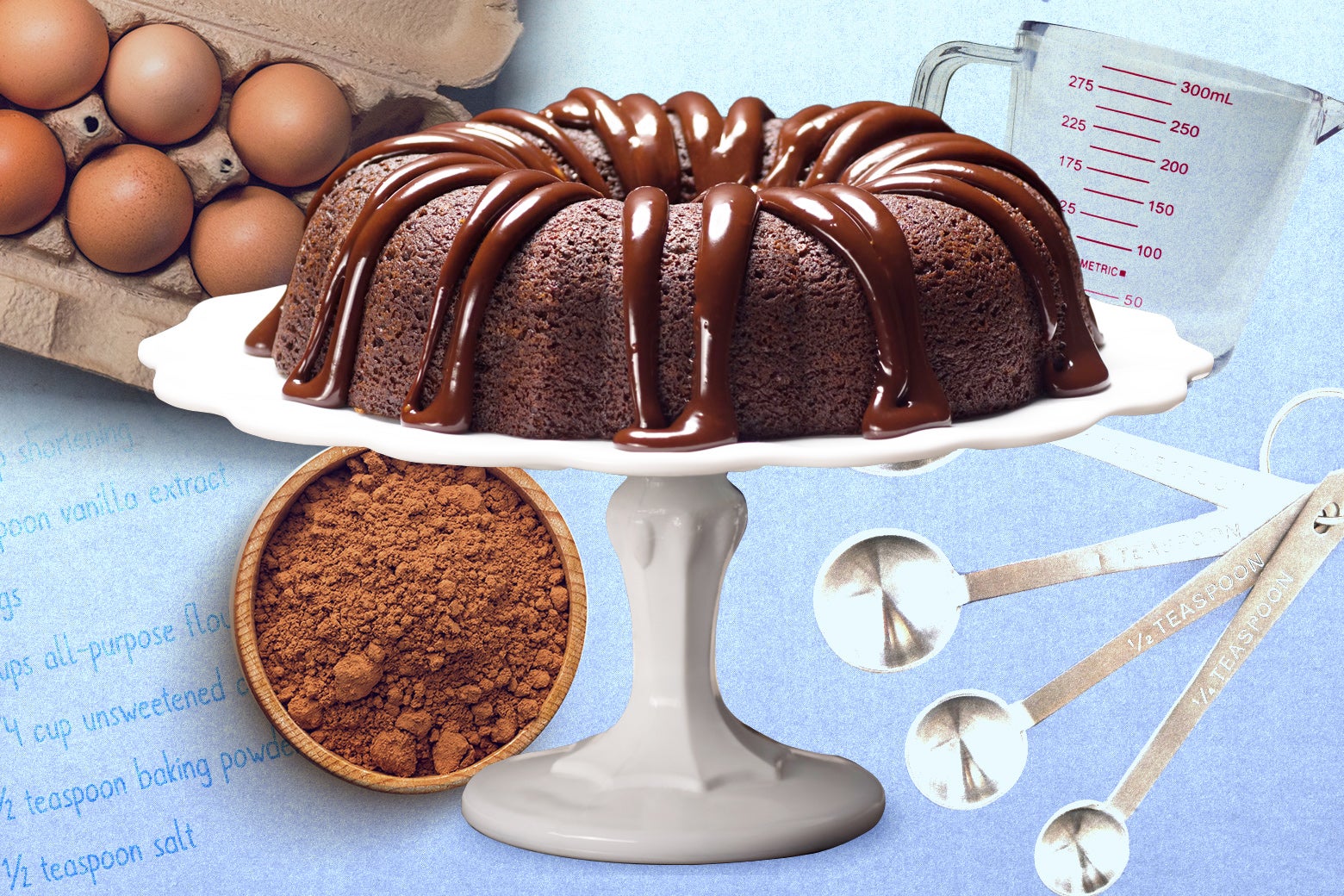Last week, I steeled my courage, pulled out my stand mixer, and prepared to bake the cake that, ever since I heard of its existence, has been my culinary white whale. Yes, once again I would attempt the alchemical magic of Pillsbury’s Tunnel of Fudge.
The Tunnel of Fudge was revolutionary when it took second prize in the Pillsbury Bake-Off of 1966. Invented by Ella Helfrich of Houston, the recipe used Pillsbury’s instant frosting powder to create an underdone, fudgy center in the middle of an otherwise unassuming ring-shaped chocolate cake. Patient Zero in the lava-cake epidemic, the Tunnel of Fudge saved the Bundt pan from likely extinction and was a go-to for the busy housewife who needed a showstopping dessert for the potluck table.
Then it disappeared, because Pillsbury discontinued the key ingredient, Pillsbury Two Layer Size Double Dutch Fudge Buttercream Frosting Mix. In the decades since, legions of home cooks have attempted to replicate the gooey delights of the Tunnel of Fudge, with little success. It remained a legend, a mystery, the Lost Ark of midcentury baking.
Until now! Last week I made the Tunnel of Fudge—and it freaking worked. It was fudgy! It was structurally sound! It tasted good! All thanks to an ingenious food scientist at Pillsbury who came up with a brand-new recipe for a very old frosting mix.
I had not been excited about baking the Tunnel of Fudge again. Last fall, as part of Slate’s project exploring the 25 most important recipes of the past 100 years, I failed once in baking the Tunnel of Fudge, and then—after a dozen emails to Pillsbury (ignored), an interview with the CEO of a different baking mix company, and the online ordering of secret ingredients—failed once more. Perhaps, I wrote then, “this cake from the era of convenience food might never make the jump into the 21st century.”
That article was read by many, many people, quite a few of whom wrote to me expressing their annoyance that they, too, had failed to make a Tunnel of Fudge cake. I learned from one reader that even the original recipe was a challenge. “My father, Howard Lincoln, was the Pillsbury food chemist assigned to create a recipe out of the Bake Off phenomenon,” she wrote. “I have vivid recollections of conversations over the dinner table with him expressing his extreme frustration because ‘the damn tunnel won’t stay in the middle of the cake!’ ”
Spurred by my failure and the widespread outcry for recompense, Pillsbury finally snapped into action. In January I received an email from a Pillsbury publicist letting me know that a food scientist in the R&D team had devised a recipe not for a new Tunnel of Fudge—the company had long posted a desultory substitute recipe online—but for the lost frosting mix, the special ingredient that made the whole thing work. Would I like to try it? “Additionally,” the publicist wrote, “we’d like to apologize for any miscommunication with our customer care team—feedback is always valuable to us.”
Dan Kois
I tried the copycat recipe for frosting mix, which was simple and required just five ingredients whizzed in a food processor. Then I tried making the Tunnel of Fudge—and gosh darn if the cake didn’t combine, as advertised, a chocolatey outer layer with a soft, fudgy interior. As I ate a piece, a single tear dropped from my cheek, adding the perfect salty touch to this hallowed dessert.
“It really just took me one try,” said Mallory Edwards, a food scientist at Pillsbury’s facility in Toledo, Ohio. “I guess it was a lucky day.” After a peripatetic career as a sculptor, a cake decorator, and a pastry chef, Edwards studied food science at Kansas State University. She’s been working for the company for about a year, inventing dry baking mixes and developing recipes for them; her first product, a Funfetti red velvet cookie mix, just hit the shelves for Valentine’s Day. (She’d proudly thumbtacked a box to the bulletin board behind her.)
“I really love going through our archives and looking at the old packaging and old recipes,” Edwards said. “It reminds me of my grandma.” So, when higher-ups asked her to replicate the Tunnel of Fudge, she immediately recalled the old frosting mix packaging she’d seen in the files. “I love those old frosting mixes. I’m a big chocolate frosting fan.” I asked her why she thought frosting mix had gone out of fashion, and she laughed. “I think people just figured out that it’s really just a box of powdered sugar, at the end of the day. They thought, I’m not gonna pay for that.”
Nevertheless, the old box served a useful purpose in re-creating the original recipe. “You can kind of reverse engineer an ingredient list if you also have the nutrition label,” she said. “I was like: Why does this work? I figured it’s because you’re overloading this cake with sugar.” The frosting mix seemed to contain a lot of sugar and also cornstarch; sugar, she explained, increases the temperature required to gelatinize starch, so the cake’s center remains liquidy-ish even though the cake gets hot enough to be food-safe.
Well, it really worked, I told her. My Tunnel of Fudge finally turned out. “I’m glad,” she said. “I was worried you were going to say it didn’t work, and I would have to be like, ‘I don’t know what to tell you. It should work.’ ” Very diplomatic.
I had one final question for this intrepid food hero who had returned the Tunnel of Fudge to the world nearly 60 years after its invention. Was it OK if I replaced walnuts, which no one likes, with hazelnuts? “Sure, if it works,” she said. “The recipe claims the nuts are integral to the structure. I don’t know about that. I’ve never studied any nut science.”
Recipe: Pillsbury Bake-Off Tunnel of Fudge
By Ella Helfrich, Howard Lincoln, and Mallory Edwards
The Tunnel of Fudge cake was first invented by Ella Helfrich of Houston in the 1960s. A Pillsbury food chemist, Howard Lincoln, developed the recipe using dry frosting mix in 1966. In 2025 another Pillsbury food scientist, Mallory Edwards, created a copycat version of that discontinued frosting mix.
Frosting mix:
1 ¾ cups powdered sugar
½ cup cocoa powder
5 tablespoons cornstarch
2 tablespoons vegetable shortening
¼ teaspoon salt
Blend ingredients in food processor until combined. This will yield the equivalent of one box of Double Dutch Fudge Buttercream Frosting Mix.
Cake:
1 ½ cups butter, softened
6 eggs
1 ½ cups sugar
2 cups all-purpose flour
1 recipe Double Dutch Fudge Buttercream Frosting Mix (see above)
2 cups chopped walnuts or, if you prefer, actually good nuts like hazelnuts or whatever
Preheat the oven to 350 degrees.
Beat the butter at high speed until fluffy. Beat in the eggs one at a time. Gradually add the sugar and beat until fluffy. By hand, stir in the flour, the frosting mix, and the nuts.
Spoon cake batter into a greased Bundt pan and level the top. Bake for 55 to 60 minutes—until top is dry and shiny. (A toothpick or other doneness test will not work, as by design the interior of the cake should be “underdone.” Trust the process!!!)
Cool in pan 2 hours, then carefully turn over onto a cake plate.



:max_bytes(150000):strip_icc():focal(1013x496:1015x498)/Morgan-Wallen-Son-Dog-Attack-062023-9abfc02b26214d24bf55d60732b1ddf9.jpg)






:max_bytes(150000):strip_icc()/GettyImages-2205311959-4e81505b5b11480ca8212c656df19309.jpg)





